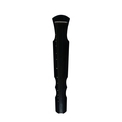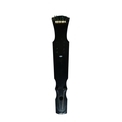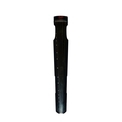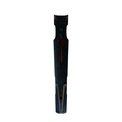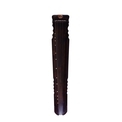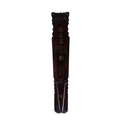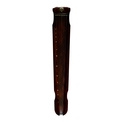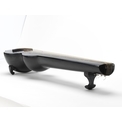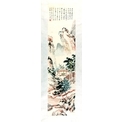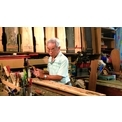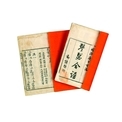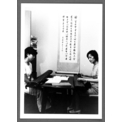The ninth step of qin making process: stringing
After the lacquered surface has been polished, a tone tester is used to perform an acoustic test of the qin’s sound. If there is buzzing noise, it means the top board of the qin requires further conditioning or another round of cement priming and lacquering. When the lacquering process is complete, the instrument can be stringed and tuned. To mount strings onto the qin, use the tuning tassels (rongkou), which connect with the tuning pegs at the qin bottom, to hook the butterfly bow (yingtou) of the string at the bridge. Tie the other end of each string, around the dragon gum, to the goose feet. Next, turn the pegs to tune. The first group of thicker strings – the first to the fourth – are fastened onto the right goose foot, while the second group of thinner strings – the fifth to the seventh – are tied to the left goose foot. The thicker strings should be mounted first, followed by the thinner ones. New silk strings have to be mounted a few times before they are stabilised. This photo shows the ninth step of qin making process which was demonstrated by Choi Chang-sau.
| Date | 2013 |
| People | Choi Chang-sau |
| Material Type | Image |
| Collection | The Legend of Silk and Wood: A Hong Kong Qin Story |
| Source | Intangible Cultural Heritage Office and Hong Kong Heritage Museum |
| Repository | Intangible Cultural Heritage Office |
| Note to Copyright | Permission for use in Hong Kong Memory is given by Intangible Cultural Heritage Office and Hong Kong Heritage Museum |
| Accession No. | lcs-hkqs-0124 |
The ninth step of qin making process: stringing
After the lacquered surface has been polished, a tone tester is used to perform an acoustic test of the qin’s sound. If there is buzzing noise, it means the top board of the qin requires further conditioning or another round of cement priming and lacquering. When the lacquering process is complete, the instrument can be stringed and tuned. To mount strings onto the qin, use the tuning tassels (rongkou), which connect with the tuning pegs at the qin bottom, to hook the butterfly bow (yingtou) of the string at the bridge. Tie the other end of each string, around the dragon gum, to the goose feet. Next, turn the pegs to tune. The first group of thicker strings – the first to the fourth – are fastened onto the right goose foot, while the second group of thinner strings – the fifth to the seventh – are tied to the left goose foot. The thicker strings should be mounted first, followed by the thinner ones. New silk strings have to be mounted a few times before they are stabilised. This photo shows the ninth step of qin making process which was demonstrated by Choi Chang-sau.
| Date | 2013 |
| People | Choi Chang-sau |
| Material Type | Image |
| Collection | The Legend of Silk and Wood: A Hong Kong Qin Story |
| Source | Intangible Cultural Heritage Office and Hong Kong Heritage Museum |
| Repository | Intangible Cultural Heritage Office |
| Note to Copyright | Permission for use in Hong Kong Memory is given by Intangible Cultural Heritage Office and Hong Kong Heritage Museum |
| Accession No. | lcs-hkqs-0124 |
The ninth step of qin making process: stringing
After the lacquered surface has been polished, a tone tester is used to perform an acoustic test of the qin’s sound. If there is buzzing noise, it means the top board of the qin requires further conditioning or another round of cement priming and lacquering. When the lacquering process is complete, the instrument can be stringed and tuned. To mount strings onto the qin, use the tuning tassels (rongkou), which connect with the tuning pegs at the qin bottom, to hook the butterfly bow (yingtou) of the string at the bridge. Tie the other end of each string, around the dragon gum, to the goose feet. Next, turn the pegs to tune. The first group of thicker strings – the first to the fourth – are fastened onto the right goose foot, while the second group of thinner strings – the fifth to the seventh – are tied to the left goose foot. The thicker strings should be mounted first, followed by the thinner ones. New silk strings have to be mounted a few times before they are stabilised. This photo shows the ninth step of qin making process which was demonstrated by Choi Chang-sau.
| Date | 2013 |
| People | Choi Chang-sau |
| Material Type | Image |
| Collection | The Legend of Silk and Wood: A Hong Kong Qin Story |
| Source | Intangible Cultural Heritage Office and Hong Kong Heritage Museum |
| Repository | Intangible Cultural Heritage Office |
| Note to Copyright | Permission for use in Hong Kong Memory is given by Intangible Cultural Heritage Office and Hong Kong Heritage Museum |
| Accession No. | lcs-hkqs-0124 |
The ninth step of qin making process: stringing
After the lacquered surface has been polished, a tone tester is used to perform an acoustic test of the qin’s sound. If there is buzzing noise, it means the top board of the qin requires further conditioning or another round of cement priming and lacquering. When the lacquering process is complete, the instrument can be stringed and tuned. To mount strings onto the qin, use the tuning tassels (rongkou), which connect with the tuning pegs at the qin bottom, to hook the butterfly bow (yingtou) of the string at the bridge. Tie the other end of each string, around the dragon gum, to the goose feet. Next, turn the pegs to tune. The first group of thicker strings – the first to the fourth – are fastened onto the right goose foot, while the second group of thinner strings – the fifth to the seventh – are tied to the left goose foot. The thicker strings should be mounted first, followed by the thinner ones. New silk strings have to be mounted a few times before they are stabilised. This photo shows the ninth step of qin making process which was demonstrated by Choi Chang-sau.
| Date | 2013 |
| People | Choi Chang-sau |
| Material Type | Image |
| Collection | The Legend of Silk and Wood: A Hong Kong Qin Story |
| Source | Intangible Cultural Heritage Office and Hong Kong Heritage Museum |
| Repository | Intangible Cultural Heritage Office |
| Note to Copyright | Permission for use in Hong Kong Memory is given by Intangible Cultural Heritage Office and Hong Kong Heritage Museum |
| Accession No. | lcs-hkqs-0124 |
The ninth step of qin making process: stringing
After the lacquered surface has been polished, a tone tester is used to perform an acoustic test of the qin’s sound. If there is buzzing noise, it means the top board of the qin requires further conditioning or another round of cement priming and lacquering. When the lacquering process is complete, the instrument can be stringed and tuned. To mount strings onto the qin, use the tuning tassels (rongkou), which connect with the tuning pegs at the qin bottom, to hook the butterfly bow (yingtou) of the string at the bridge. Tie the other end of each string, around the dragon gum, to the goose feet. Next, turn the pegs to tune. The first group of thicker strings – the first to the fourth – are fastened onto the right goose foot, while the second group of thinner strings – the fifth to the seventh – are tied to the left goose foot. The thicker strings should be mounted first, followed by the thinner ones. New silk strings have to be mounted a few times before they are stabilised. This photo shows the ninth step of qin making process which was demonstrated by Choi Chang-sau.
| Date | 2013 |
| People | Choi Chang-sau |
| Material Type | Image |
| Collection | The Legend of Silk and Wood: A Hong Kong Qin Story |
| Source | Intangible Cultural Heritage Office and Hong Kong Heritage Museum |
| Repository | Intangible Cultural Heritage Office |
| Note to Copyright | Permission for use in Hong Kong Memory is given by Intangible Cultural Heritage Office and Hong Kong Heritage Museum |
| Accession No. | lcs-hkqs-0124 |
The ninth step of qin making process: stringing
After the lacquered surface has been polished, a tone tester is used to perform an acoustic test of the qin’s sound. If there is buzzing noise, it means the top board of the qin requires further conditioning or another round of cement priming and lacquering. When the lacquering process is complete, the instrument can be stringed and tuned. To mount strings onto the qin, use the tuning tassels (rongkou), which connect with the tuning pegs at the qin bottom, to hook the butterfly bow (yingtou) of the string at the bridge. Tie the other end of each string, around the dragon gum, to the goose feet. Next, turn the pegs to tune. The first group of thicker strings – the first to the fourth – are fastened onto the right goose foot, while the second group of thinner strings – the fifth to the seventh – are tied to the left goose foot. The thicker strings should be mounted first, followed by the thinner ones. New silk strings have to be mounted a few times before they are stabilised. This photo shows the ninth step of qin making process which was demonstrated by Choi Chang-sau.
| Date | 2013 |
| People | Choi Chang-sau |
| Material Type | Image |
| Collection | The Legend of Silk and Wood: A Hong Kong Qin Story |
| Source | Intangible Cultural Heritage Office and Hong Kong Heritage Museum |
| Repository | Intangible Cultural Heritage Office |
| Note to Copyright | Permission for use in Hong Kong Memory is given by Intangible Cultural Heritage Office and Hong Kong Heritage Museum |
| Accession No. | lcs-hkqs-0124 |
The ninth step of qin making process: stringing
After the lacquered surface has been polished, a tone tester is used to perform an acoustic test of the qin’s sound. If there is buzzing noise, it means the top board of the qin requires further conditioning or another round of cement priming and lacquering. When the lacquering process is complete, the instrument can be stringed and tuned. To mount strings onto the qin, use the tuning tassels (rongkou), which connect with the tuning pegs at the qin bottom, to hook the butterfly bow (yingtou) of the string at the bridge. Tie the other end of each string, around the dragon gum, to the goose feet. Next, turn the pegs to tune. The first group of thicker strings – the first to the fourth – are fastened onto the right goose foot, while the second group of thinner strings – the fifth to the seventh – are tied to the left goose foot. The thicker strings should be mounted first, followed by the thinner ones. New silk strings have to be mounted a few times before they are stabilised. This photo shows the ninth step of qin making process which was demonstrated by Choi Chang-sau.
| Date | 2013 |
| People | Choi Chang-sau |
| Material Type | Image |
| Collection | The Legend of Silk and Wood: A Hong Kong Qin Story |
| Source | Intangible Cultural Heritage Office and Hong Kong Heritage Museum |
| Repository | Intangible Cultural Heritage Office |
| Note to Copyright | Permission for use in Hong Kong Memory is given by Intangible Cultural Heritage Office and Hong Kong Heritage Museum |
| Accession No. | lcs-hkqs-0124 |
The ninth step of qin making process: stringing
After the lacquered surface has been polished, a tone tester is used to perform an acoustic test of the qin’s sound. If there is buzzing noise, it means the top board of the qin requires further conditioning or another round of cement priming and lacquering. When the lacquering process is complete, the instrument can be stringed and tuned. To mount strings onto the qin, use the tuning tassels (rongkou), which connect with the tuning pegs at the qin bottom, to hook the butterfly bow (yingtou) of the string at the bridge. Tie the other end of each string, around the dragon gum, to the goose feet. Next, turn the pegs to tune. The first group of thicker strings – the first to the fourth – are fastened onto the right goose foot, while the second group of thinner strings – the fifth to the seventh – are tied to the left goose foot. The thicker strings should be mounted first, followed by the thinner ones. New silk strings have to be mounted a few times before they are stabilised. This photo shows the ninth step of qin making process which was demonstrated by Choi Chang-sau.
| Date of Death | 2013 |
| People | Choi Chang-sau |
| Material Type | Image |
| Collection | The Legend of Silk and Wood: A Hong Kong Qin Story |
| Source | Intangible Cultural Heritage Office and Hong Kong Heritage Museum |
| Repository | Intangible Cultural Heritage Office |
| Note to Copyright | Permission for use in Hong Kong Memory is given by Intangible Cultural Heritage Office and Hong Kong Heritage Museum |
| Accession No. | lcs-hkqs-0124 |
The ninth step of qin making process: stringing
After the lacquered surface has been polished, a tone tester is used to perform an acoustic test of the qin’s sound. If there is buzzing noise, it means the top board of the qin requires further conditioning or another round of cement priming and lacquering. When the lacquering process is complete, the instrument can be stringed and tuned. To mount strings onto the qin, use the tuning tassels (rongkou), which connect with the tuning pegs at the qin bottom, to hook the butterfly bow (yingtou) of the string at the bridge. Tie the other end of each string, around the dragon gum, to the goose feet. Next, turn the pegs to tune. The first group of thicker strings – the first to the fourth – are fastened onto the right goose foot, while the second group of thinner strings – the fifth to the seventh – are tied to the left goose foot. The thicker strings should be mounted first, followed by the thinner ones. New silk strings have to be mounted a few times before they are stabilised. This photo shows the ninth step of qin making process which was demonstrated by Choi Chang-sau.
| Date | 2013 |
| Material Type | Image |
| Collection | The Legend of Silk and Wood: A Hong Kong Qin Story |
| Source | Intangible Cultural Heritage Office and Hong Kong Heritage Museum |
| Note to Copyright | Permission for use in Hong Kong Memory is given by Intangible Cultural Heritage Office and Hong Kong Heritage Museum |
| Accession No. | lcs-hkqs-0124 |
The ninth step of qin making process: stringing
After the lacquered surface has been polished, a tone tester is used to perform an acoustic test of the qin’s sound. If there is buzzing noise, it means the top board of the qin requires further conditioning or another round of cement priming and lacquering. When the lacquering process is complete, the instrument can be stringed and tuned. To mount strings onto the qin, use the tuning tassels (rongkou), which connect with the tuning pegs at the qin bottom, to hook the butterfly bow (yingtou) of the string at the bridge. Tie the other end of each string, around the dragon gum, to the goose feet. Next, turn the pegs to tune. The first group of thicker strings – the first to the fourth – are fastened onto the right goose foot, while the second group of thinner strings – the fifth to the seventh – are tied to the left goose foot. The thicker strings should be mounted first, followed by the thinner ones. New silk strings have to be mounted a few times before they are stabilised. This photo shows the ninth step of qin making process which was demonstrated by Choi Chang-sau.
| Date | 2013 |
| Material Type | Image |
| People | Choi Chang-sau |
| Collection | The Legend of Silk and Wood: A Hong Kong Qin Story |
| Source | Intangible Cultural Heritage Office and Hong Kong Heritage Museum |
| Repository | Intangible Cultural Heritage Office |
| Note to Copyright | Permission for use in Hong Kong Memory is given by Intangible Cultural Heritage Office and Hong Kong Heritage Museum |
| Accession No. | lcs-hkqs-0124 |
Copyright © 2012 Hong Kong Memory


